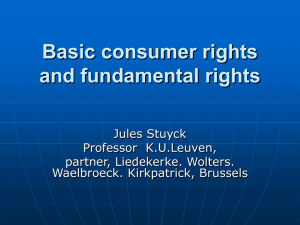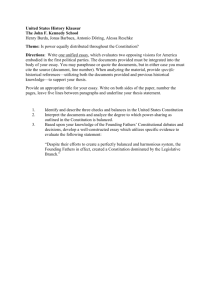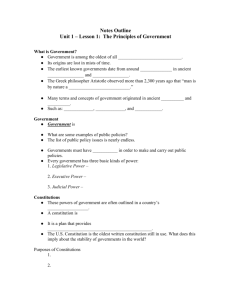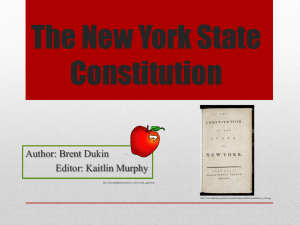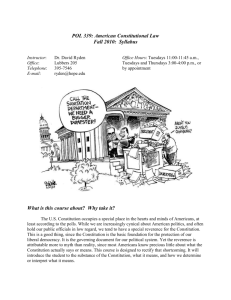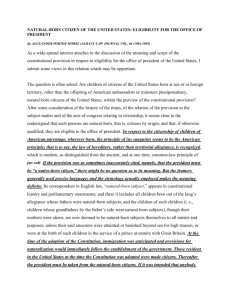quiz: reporting category 2: roles, rights, and responsibilities of citizens
advertisement
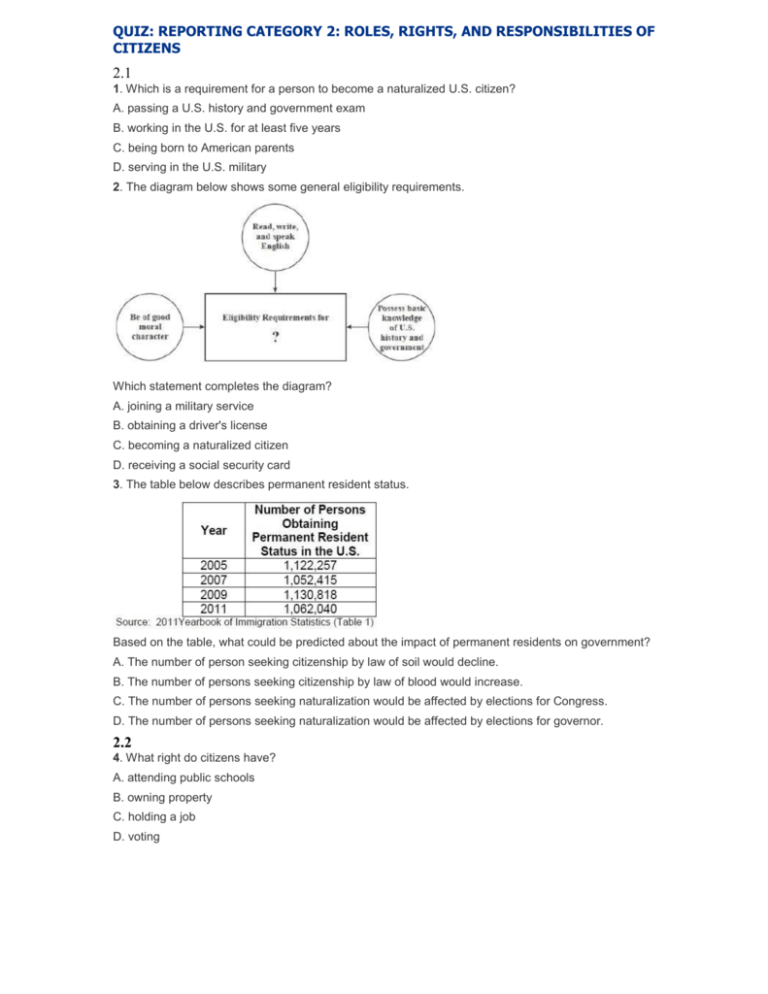
QUIZ: REPORTING CATEGORY 2: ROLES, RIGHTS, AND RESPONSIBILITIES OF CITIZENS 2.1 1. Which is a requirement for a person to become a naturalized U.S. citizen? A. passing a U.S. history and government exam B. working in the U.S. for at least five years C. being born to American parents D. serving in the U.S. military 2. The diagram below shows some general eligibility requirements. Which statement completes the diagram? A. joining a military service B. obtaining a driver's license C. becoming a naturalized citizen D. receiving a social security card 3. The table below describes permanent resident status. Based on the table, what could be predicted about the impact of permanent residents on government? A. The number of person seeking citizenship by law of soil would decline. B. The number of persons seeking citizenship by law of blood would increase. C. The number of persons seeking naturalization would be affected by elections for Congress. D. The number of persons seeking naturalization would be affected by elections for governor. 2.2 4. What right do citizens have? A. attending public schools B. owning property C. holding a job D. voting 5. The illustration below shows a legal document. Why are citizens obligated to respond to such documents? A. to guarantee court hearings remain public B. to guarantee courts provide probable cause C. to protect the constitutional right to be tried by one's peers D. to protect the constitutional right to confronts one's accuser 6. The image below describes a citizen obligation. Based on this image, what can be presumed about citizen obligations? A. Citizens support attending civic meetings. B. Citizens support securing individual rights. C. Citizens resist registering for selective service. D. Citizens resist contributing to the common good. 2.4 7. Where can a description of U.S. citizens' civil liberties be found? A. Declaration of Independence B. Preamble to the Constitution C. Pledge of Allegiance D. Bill of Rights 8..The statement below was made by Thomas Jefferson in a 1786 letter to John Jay. Why should this freedom be guarded? A. to provide the news media with a guaranteed profit B. to keep the news media from controlling the political process C. to provide the government with an accurate information source D. to keep the government from becoming the primary information source 9. The passage below is one of the grievances found in the Declaration of Independence. Which rights listed in the Bill of Rights reflects this complaint? A. due process of law, assistance of counsel, speedy and public trial B. equal protection, assistance of counsel, speedy and public trial C. bear arms, due process of law, speedy and public trial D. bear arms, equal protection, speedy and public trial 2.5 10. Which right is NOT mentioned in the U.S. Constitution? A. petition the government B. due process of the law C. trial by jury D. privacy 11. The passage below about government in from Federalist No. 51. How are the author's views from this passage applied in the U.S. Constitution? A. The U.S. Constitution limits the rights of the people. B. The U.S. Constitution limits the power of the federal government. C. The U.S. Constitution requires the states to provide for the common defense. D. The U.S. Constitution requires the government to promote the general welfare. 12. The timeline below shows events related to the death penalty. What constitutional protections have resulted from these events? A. Constitutional protections from cruel and unusual punishment are safeguarded while executions continue. B. Constitutional protections from cruel and unusual punishment are limited while executions continue. C. Constitutional protections of due process of law are safeguarded while executions continue. D. Constitutional protections of due process of law are limited while executions continue. 3.6 13. Which individual protection is found in the Fifth Amendment to the U.S. Constitution? A. privacy rights B. property rights C. forced internment D. civil disobedience 14. Which action represents an individual exercising a constitutional right? A. summary judgment B. quartering soldiers C. civil disobedience D. double jeopardy 15. What has been one long-term result of the constitutional protection of free speech? A. fewer court cases involving minors B. fewer laws limiting minority rights C. a more accurate election D. a more informed society 3.7 16. How did the passage of the Voting Rights of 1965 impact political participation? A. All person who passed a literacy test could now vote. B. All children of foreign citizens could now vote. C. All African-Americans could now vote. D. All women could now vote. 17. The photograph below illustrates an event in U.S. history. What was Congress' response to the social movement symbolized in the photograph? A. decreased commerce opportunities B. increased economic opportunities C. increased religious opportunities D. decreased military opportunities 18. The newspaper below details an important step in amending the U.S. Constitution. How did the passage of this amendment to the U.S. Constitution impact the political process in the United States? A. Women were allowed to contribute to political campaigns. B. Women were allowed to hold citizenship rights. C. Women were allowed to hold public offices. D. Women were allowed to vote in national elections. 3.12 19. In which case did the U.S. Supreme Court rule that the Florida Supreme Court's plan for recounting ballots violated the Equal Protection Clause of the Fourteenth Amendment? A. Hazelwood v. Kuhlmeier (1988) B. Gideon v. Wainwright (1963) C. U.S. v. Nixon (1974) D. Bush v. Gore (2000) 20. Which was an outcome of the U.S. Supreme Court decision in Brown v. Board of Education (1954)? A. Administrators may limit the content of students publications. B. Public school districts that segregate deny equal protection. C. Students have a reduced expectation of privacy in school. D. Criminal defendants have the right to an attorney. 21. What lessons did future U.S. leaders learn from the 1974 U.S. Supreme Court case United States v. Nixon? A. The president is accountable for obeying the law. B. The president is responsible for enforcing the law. C. The president is not allowed to hold secret talks with foreign governments. D. The president is not allowed to have private meetings with Cabinet members. ANSWER KEY 1. a 2. c 3. c 4. d 5. c 6. d 7. d 8. d 9. a 10. d 11. b 12. a 13. b 14. c 15. d 16. c 17. b 18. d 19. d 20. b 21. a



